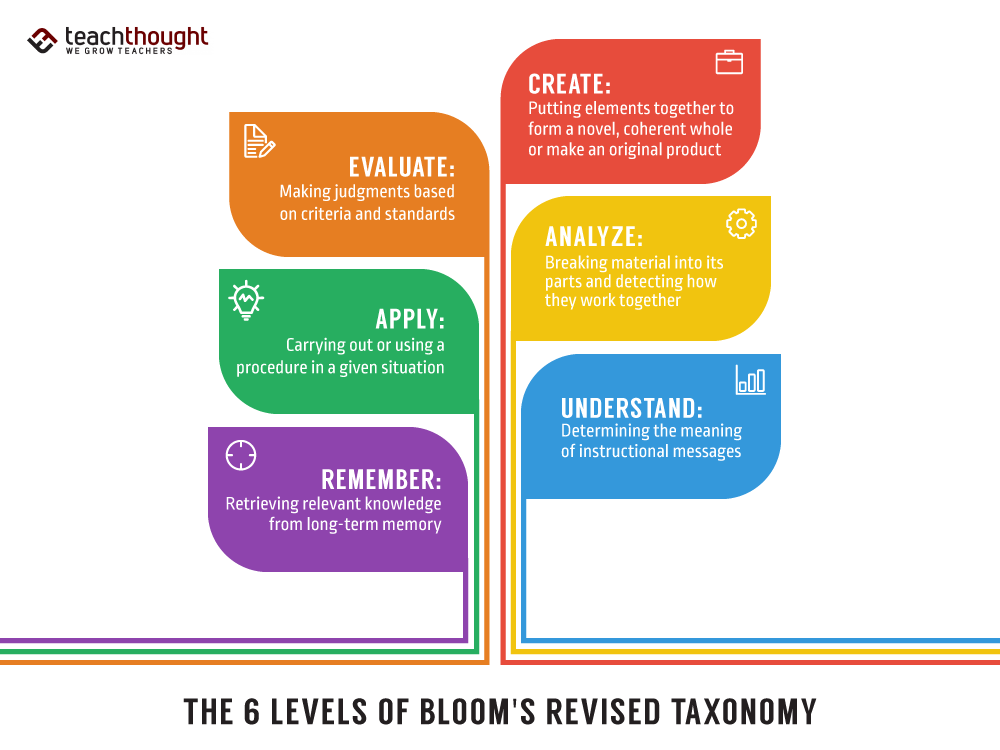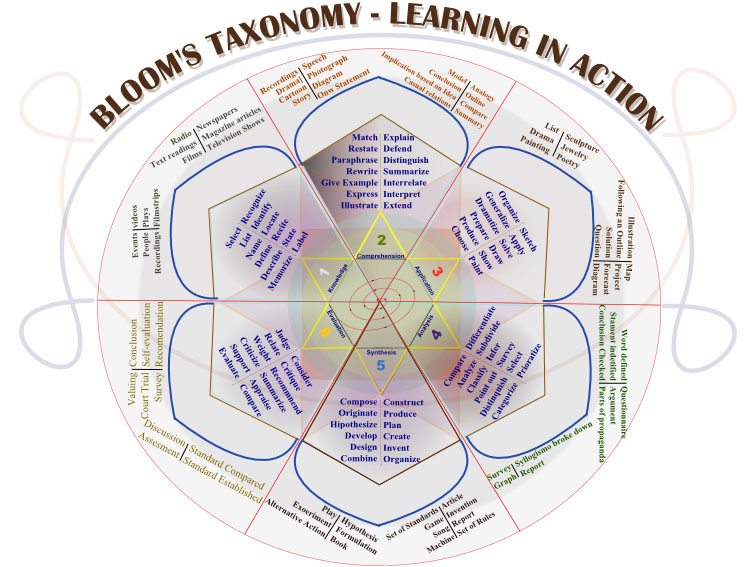Bloom’s Revised Taxonomy: The 6 Cognitive Levels Explained
Updated November 5, 2025 • TeachThought Staff

Bloom’s Revised Taxonomy updates the original 1956 framework to clarify cognitive processes and support modern instructional planning. The revision emphasizes what learners do, uses action verbs, and introduces a knowledge dimension that helps align tasks, assessments, and outcomes.
See also: Bloom’s Taxonomy Verbs List · Bloom’s Digital Verbs · TeachThought: Critical Thinking
Why Bloom’s Taxonomy Was Revised
- Shift from nouns to verbs to foreground cognitive action.
- Clarify the hierarchy and reduce overlap among adjacent levels.
- Add a knowledge dimension to distinguish factual, conceptual, procedural, and metacognitive knowledge.
- Align with contemporary assessment and curriculum design practices.
What Changed From the Original
| Original (1956) | Revised (2001) | Notes |
|---|---|---|
| Knowledge | Remember | Noun to verb. Focus on recall and recognition. |
| Comprehension | Understand | Interpretation, summarizing, explaining. |
| Application | Apply | Use procedures in new or routine contexts. |
| Analysis | Analyze | Differentiate, organize, attribute. |
| Synthesis | Create | Create moved to the top to reflect generative thinking. |
| Evaluation | Evaluate | Judge based on criteria and standards. |
The Knowledge Dimension
The revision adds a knowledge dimension to clarify what knowledge type learners work with during a task.
- Factual. Specific details and terminology.
- Conceptual. Classifications, principles, theories, and models.
- Procedural. Methods, techniques, and criteria for use.
- Metacognitive. Knowledge of strategies, self-monitoring, and self-regulation.
The Six Cognitive Process Levels
1. Remember
Retrieve facts or information with accuracy.
- Examples. List key terms. Recall dates. Label diagrams.
- Classroom use. Warm-up retrieval practice. Exit tickets. Low-stakes quizzes.
2. Understand
Explain ideas or concepts in one’s own words.
- Examples. Summarize a text. Classify examples. Explain a process.
- Classroom use. Concept maps. Think-pair-share. Brief teach-back.
3. Apply
Use procedures to solve problems or complete tasks.
- Examples. Compute with a method. Conduct a lab step. Use a rule to solve a case.
- Classroom use. Worked examples. Practice sets. Station tasks.
4. Analyze
Break material into parts and determine how they relate.
- Examples. Compare arguments. Identify assumptions. Organize evidence.
- Classroom use. Evidence charts. Claim-reason data tables. Pattern finding.
5. Evaluate
Make judgments based on criteria and standards.
- Examples. Critique a solution. Justify a position. Assess source credibility.
- Classroom use. Rubric-based peer review. Structured debates. Editorial responses.
6. Create
Generate new products, ideas, or solutions by combining elements.
- Examples. Design an investigation. Compose a narrative. Propose a prototype.
- Classroom use. Project briefs. Design sprints. Public product showcases.
Planning With Bloom’s Revised Taxonomy
- Clarify outcomes. State what learners will do and which knowledge type is targeted.
- Sequence tasks. Move from foundational knowledge toward analysis, evaluation, and creation as appropriate for grade and context.
- Align assessments. Match the cognitive level of tasks and assessments to the stated outcomes.
- Use verbs carefully. Select verbs that reflect the level and avoid vague phrasing.
- Support learners. Add models, exemplars, and scaffolds to make higher-level tasks accessible.
Common Misunderstandings
- Assuming the taxonomy is a fixed ladder. Learners often move among levels within a single task.
- Confusing verb choice with rigor. The quality of the task and evidence matters more than the verb alone.
- Ignoring knowledge types. A precise outcome states both the action and the knowledge focus.
Bloom’s Revised Taxonomy: Frequently Asked Questions
What is the main difference between the original and revised taxonomy.
The revision uses action verbs for the cognitive processes and adds a knowledge dimension. It relocates Create to the top to highlight generative thinking.
Is Bloom’s Taxonomy a strict hierarchy.
No. It is a useful framework, not a rigid ladder. Learners often move across levels within a task or unit.
How should I choose the right verb.
Select a verb that matches the intended cognitive process and the knowledge type. Then design evidence that fits the outcome. See our verbs list for examples.
Does higher level always mean better.
Not always. Match the level to purpose and learner readiness. Strong instruction often blends levels to build understanding and transfer.
How does this help with assessment.
Use the framework to ensure the assessment evidence matches the outcome. If the outcome requires Analyze, design tasks that require analysis, not only recall.
References & Further Reading
- Anderson, L. W., & Krathwohl, D. R. (2001). A Taxonomy for Learning, Teaching, and Assessing: A Revision of Bloom’s Taxonomy of Educational Objectives. New York: Longman.
- Churches, A. (2009). Bloom’s Digital Taxonomy. Retrieved from edorigami.edublogs.org
- Bloom’s Taxonomy: Revised and Digital Versions (Teaching & Learning Resource) .
